The jazz melodic minor scale is a very important improvisational tool.
Chops: Intermediate
Theory: Intermediate/Advanced
Lesson Overview:
• Unlock the secrets of the jazz
melodic minor scale.
• Develop phrases that highlight
the diatonic and altered extensions
found in dominant chords.
• Create lines over major, minor,
and half-diminished chords.
The jazz melodic minor scale is a very important improvisational tool. You may have heard of this scale before but without the word “jazz” associated with it, and perhaps you’re wondering what makes a melodic minor scale “jazz.” The formula for this scale is 1–2–b3–4–5–6–7. In classical music circles, this form of the melodic minor is only used when the scale ascends, with the natural minor (off the same root) used for descending phrases. Most modern musicians, especially in jazz, stick to using the melodic minor scale both for ascending and descending. I first saw this scale referred to as a jazz melodic minor scale in George Russell’s groundbreaking book The Lydian Chromatic Concept. Since then, I have always used this as my reference point.
In understanding how to use the jazz melodic minor scale, we must first take a look at the diatonic chords that are generated from the scale. Fig. 1 shows us the diatonic 7th chords for the C jazz melodic minor scale. These are important chords to put to memory.

I want to draw your attention to the chords built off of the 7th degree. You’ll see first that I have a Bm7b5 chord built off the 7. That’s a legit chord, but there’s a much more useful way of using the 7th degree to generate a diatonic chord that opens up our improvisational possibilities. Notice in the scale we also have Eb, which is enharmonic to D#. Next to that original chord I have a B7b5, which uses the D# as its 3rd degree. By making the VII chord a dominant chord (as opposed to a m7b5), we open up the improvisational options that are found in this scale.
If you look at Fig. 2, you’ll notice I have placed the diatonic extensions on top of five of the diatonic chords of this melodic minor scale (CmMaj7, F7, G7, Am7b5, B7alt). By understanding the diatonic extensions generated on top of these chords, we can better understand how to use the melodic minor scale in improvisation. Each of the following examples will demonstrate the basic rules for starting to improvise with this scale over minor, dominant, and half-diminished chords.

We try out this scale over a minor 7th chord in Fig. 3. This is likely the easiest way to dip your toe in the water. Simply play the scale based off the chord root—in this case, the chord is Cm7—and it not only brings out the leading tone (B), but also the 9th (D), 11th (F), and 13th (A) of the chord.
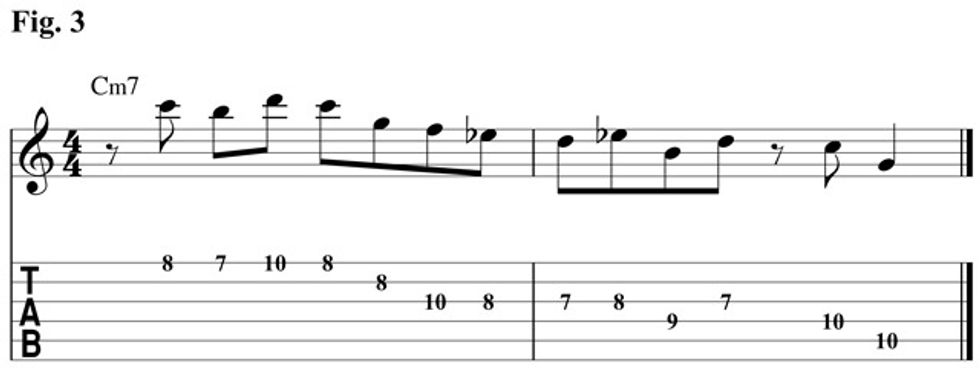
On dominant chords, we want to change our thinking a bit and base the scale off the 5th of the chord. In Fig. 4, we want to highlight the sound of an F7 chord, but also hit some cool extensions such as the 9 and #11. The 5th of F7 is C, so the C jazz melodic minor works great here.
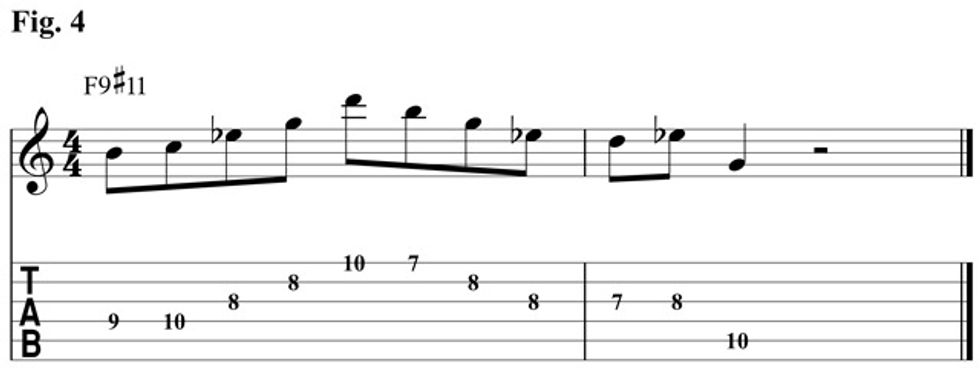
Another choice for dominant chords is to play off the 4th degree of the scale. We have a G7 chord in Fig. 5, and when we use our C jazz melodic minor scale it highlights the b13 of the chord, giving it a more tense, altered sound. Mental note: Try this application out over the V chord in a minor II-V7 progression.
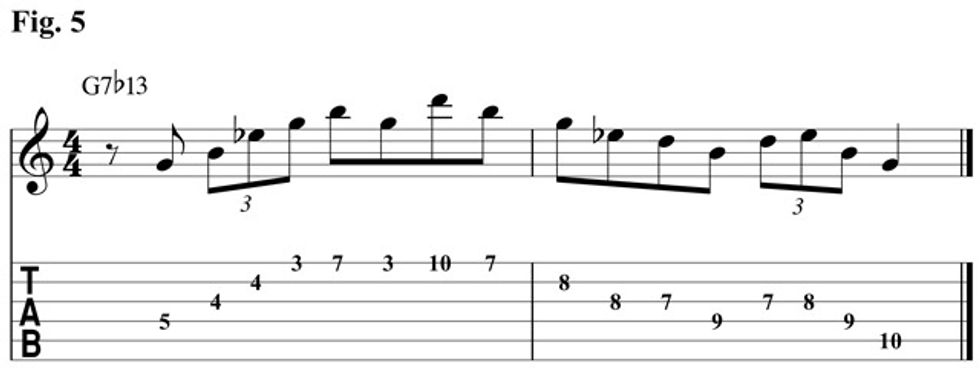
We are now going to progress into full altered-chord mode. Over the B7alt chord in Fig. 6, we’ll play a jazz melodic minor scale that starts a half-step above the root. We hit all the extensions here (b9, #9, #11, b13) making the resolution note (Eb or D#, the 3rd of the chord) even more important.
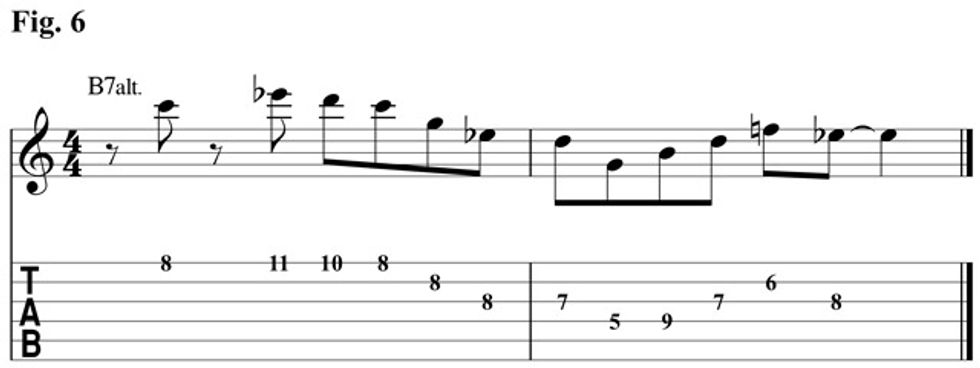
Finally, we don’t want to leave out the half-diminished—or m7b5—chords. When faced with one of these, start your scale on the b3rd. We keep our C jazz melodic minor scale going over the Am7b5 chord in Fig. 7. Again, a great scale choice for the IIm chord in a minor II-V.
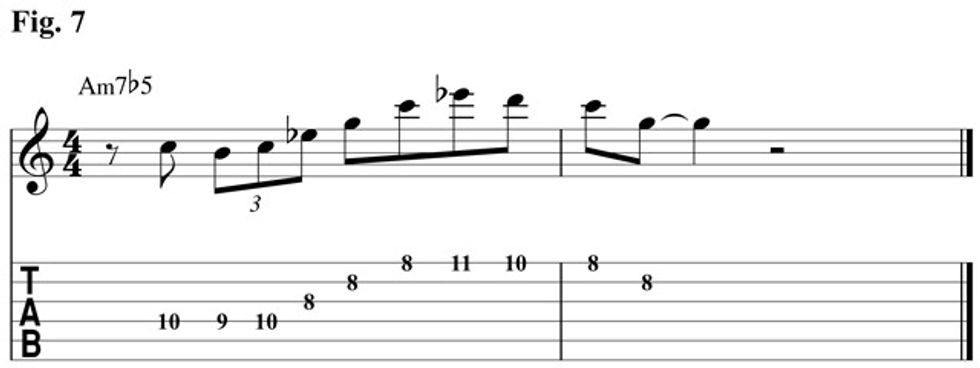
You may also be familiar with the modes of the melodic minor scale or have heard about them in passing. They are definitely worth investigating, but beyond the scope of this lesson. However, if you want to begin to improvise with the sound of the jazz melodic minor scale, start to experiment with the rules we’ve just covered. Apply the examples I have shown here to your own improvisations, and you’ll start to notice your jazz vocabulary expanding by leaps and bounds!
 Tom Dempsey Tom Dempsey is a freelance jazz guitarist
in New York City who has worked with such
luminaries as Jack McDuff, Dave Brubeck,
and Bobby McFerrin. A committed educator,
Dempsey is on the faculty of Jazz at Lincoln
Center, National Guitar Workshop, and the
New York Jazz Academy. Learn more at tomdempseymusic.com.
Tom Dempsey Tom Dempsey is a freelance jazz guitarist
in New York City who has worked with such
luminaries as Jack McDuff, Dave Brubeck,
and Bobby McFerrin. A committed educator,
Dempsey is on the faculty of Jazz at Lincoln
Center, National Guitar Workshop, and the
New York Jazz Academy. Learn more at tomdempseymusic.com.
